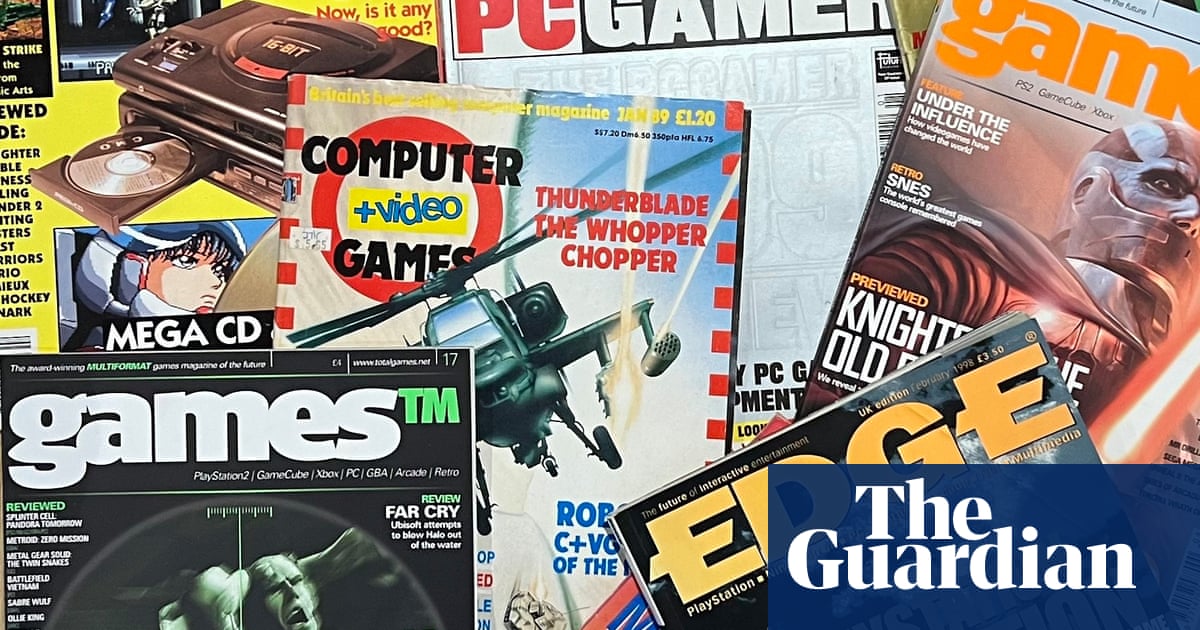
In the 21st century, video game news is available in endless streams, 24 hours a day. But if you grew up in the 1980s and 90s, you went to magazines for your gaming news, reviews and gossip. For 30 years, the UK games mag industry was a thriving sector, providing players, not only with information about games on every format, but also a sense of community. They were part newspapers, part fanzines and their writers were the YouTube streamers of their day.
I’ve been lucky enough to write for dozens of them, but before that I was an avid reader, spending all my money on these glossy celebrations of game culture. Here are, arguably, the 15 (ish) best …
15. Maximum (1995-1996)
How can a magazine that survived for barely a year make the Top 15 greatest video games mags of all time? It’s because I wrote the list, and this is one of my absolute favourites. A gruelling labour of love for founders Rich Leadbetter and art editor Gary Harrod (both Mean Machines graduates), Maximum was the size of an Argos catalogue and filled with detailed, rigorous articles on the key games of the era, accompanied by beautiful screenshots. Sales fell when games went mainstream, but nobody wrote better about Virtua Fighter 2, Ridge Racer or Tekken than these guys.
14. Retro Gamer (2004-)
Still going after 20 years, with supremely knowledgable long-term editor Darran Jones at the helm, Retro Gamer is a loving tribute to video game history and culture, densely packing its colourful pages with fascinating, revealing articles on classic games and developers. Now almost alone on newsagents’ shelves, it is a reminder of what great mags used to be before the internet arrived and ruined everything.
13. GamesMaster (1993-2018)
Originally launched as a tie-in to the famed Channel 4 video gameshow, GamesMaster took on its own identity through snappy writing, raw enthusiasm and page designs that felt almost kinetic with their myriad box-outs and screenshot sequences. Aimed squarely at young teens, it felt like learning about games from your dishevelled but much-loved big brother.
12. Sega Saturn Magazine (1995-1998)
God, this was a tough decision. There were some excellent unofficial Sega mags, including Sega Power, Sega Pro and later the awesome DC-UK (full disclosure, I was editor for 15 issues, after launch maestro, Caspar Field ), but the official Saturn Magazine was a cherished organ for Sega fans in an era dominated by PlayStation. Providing a regular demo disc and some of the best writers in the business at that time (Richard Leadbetter, Lee Nutter, Gary Cutlack) it put up a brave fight for Sega’s 32-bit machine.
11. Advanced Computer Entertainment (1987-1992)
One of Future Publishing’s first multi-format games mags, ACE as it was better known took a highly technical approach to reviewing, scoring games out of 1,000 (!) and providing a “predicted interest curve” graph which sought to predict how long players would be kept entertained. Sold to Emap in 1989, later issues came with demo cassettes and then cover disks, adding interactivity to its futuristic remit.
10. Your Sinclair (1984-1993)/Commodore User (1983-1998)
I struggled for ages trying to decide which of these to put in – and then I cheated and included them both. Operating somewhere between Viz and Have I Got News for You in tone, Your Sinclair was one of the finest examples of chaotic UK games journalism, based around running in-jokes, reader banter and fearless reviews. Commodore User was one of Emap’s longest running publications, beginning as quite a serious and technical guide to computing before transmogrifying into a great Commodore 64 and then Amiga games magazine.
9. GamesTM (2002-2018)
A relative latecomer to the games magazine market, GamesTM was launched by now defunct Highbury Publishing as an alternative to the teen-focused titles of the time. With high production values and clean, beautiful page layouts, it was a lovely magazine to peruse, and the writing was uniformly excellent. Its close coverage of the industry strayed into Edge territory, but with a lighter tone. Recently, a friend bought me an almost complete collection – and it’s been a wonderful lens through which to rediscover the games scene of the early 2000s.
8. Amiga Power (1991-1996)
Perhaps the most anarchic and chaotic games mag ever made, Amiga Power belied the stately, sensible image of Commodore’s 16bit computer with its eccentric vocabulary, surreal reviews and furious industry feuds (don’t mention Team17). At the end, with the machine itself dying, the mag carried on regardless, surviving on running jokes and completely irrelevant articles (including a four-page piece on the films of Michael Caine). I went for my first ever magazine job interview here and while I was carrying out a subbing test, Cam Winstanley and Steve Farragher threw balled up paper at my head to test my concentration. Truly the Smash Hits of gaming.
7. Arcade (1998-2000)
Arriving in the middle of a renaissance for stylish, irreverent pop-culture magazines (Neon, Uncut, Loaded in its original form), Arcade was a multi-format mag for the 1990s, with charisma, attitude and an emphasis on lifestyle features, from Jimmy White playing video games to gaming vox pops on the streets of New York. It was a brave, beautifully designed experiment, and its spirit would return very briefly in Future’s high-end PlayStation 2 mag, PSNext, edited by Arcade alumnus Sam Richards. Sadly, that would last barely a year. Lifestyle mags were already over.
6. PC Zone (1993-2010)/PC Gamer (1993-)
There was perhaps no greater rivalry in UK games mags than Gamer v Zone. Both were crazy-eyed advocates for PC gaming at a time when the consoles were in the ascendence, and both boasted brilliant writers such as my old flatmate Kieron Gillen (now a famous comic book scribe) and ever-inventive satirist Charlie Brooker (still an ever-inventive satirist, but these days on TV). Excellent industry access meant thorough interviews and preview features, and both took reviewing super seriously. Their desperate attempts to out scoop each other provided a highlight of games journalism for a decade.
5. Mean Machines (1990-1992)
Originally a section in C&VG dedicated to consoles, ex-Zzap!64 writer Julian Rignall pushed to get his passion and knowledge of the incoming Sega and Nintendo machines into a separate publication. The result was Mean Machines, an irreverent, exciting publication, which made brilliant use of box-outs and extended captions to lift games from the page. Joining Rignall were writers Richard Leadbetter and Radion Automatic, a team that brought a comedic edge to their coverage, while developing a strong sense of community with readers. A hugely influential publication that introduced many thousands to the 16bit console era.
4. Super Play (1992-1996)
Launched by Matt Bielby a few months after the more preteen-friendly Nintendo mag Total!, Super Play was aimed at hardcore fans, especially those interested in the thriving import games scene. Providing in-depth info on the latest NES and SNES releases using Japanese correspondents to get exclusive news and game reviews before anyone else, it became perhaps the greatest unofficial single-format mag of its time. Heavily influenced by Japan’s Famistu, it also featured manga-inspired art by talented designer Wil Overton, resulting in some of the most beautiful games mag covers ever made.
3. C&VG (1981-2004)
One of the first ever dedicated games magazines, C&VG set the tone for the whole industry with its editorial mix of news, previews, reviews and tips, as well as coverage of the nascent arcade scene. Early issues featured few screenshots, due to a lack of suitable technology – instead there were copious illustrations as well as program listings for readers to type into their own computers. Over its 23-year history, C&VG provided a carefully curated survey of gaming in all its forms and when it closed as a print publication (it would continue as a website until 2015), it was truly the end of an era.
2. Zzap!64 (1985-1992)/Crash (1984-1992)
Emotionally, it was impossible for me to separate these titans of the 8bit computer era. Both were launched by the much-missed Newsfield Publications with every cover beautifully illustrated by the company’s co-founder, the late Oliver Frey. They combined brilliant critical writing with proper in-depth features and a true sense of community. These magazines really taught readers how games were made, enticing a generation of fervid creators into the industry. The first autograph I ever asked for was Julian Rignall’s during his time at Zzap! – he was on the Newsfield stand at the Commodore show in Olympia and I was so starstruck I could barely speak.
1. Edge (1993-)
Sometimes po-faced and pretentious, always with a heightened sense of its own importance, Edge will be a controversial choice (Kieron Gillen has already threatened me with war), but so be it. Launched by Steve Jarrett as a video game equivalent of high-end photography magazines, Edge was – and still is – a serious, lavishly designed mix of critical essays, leading industry news and tough reviews, beloved of “pro-sumers” and developers alike. I worked there in the 90s with brilliant editor Jason Brookes, but perhaps it was the early 2000s when the magazine truly reached its zenith, holding the games business to account, sharpening its writing style and revelling as much in obscure independent studios as mammoth triple A publishers. For many years, it was Edge that got the tech specs and images of new consoles first, and it was an Edge cover that every games studio desired. An absolute institution.
Honourable mentions: obviously it was impossible to fit all the memorable publications into a list of 15 (ish) so here’s a nod to some greats I had to leave out – Amstrad Action, ST Action, Sinclair User (some of the best cover designs of the era), The One, the lovely NGC and N64 magazines, and the actually really good Official PlayStation and Xbox mags. What have I overlooked? Let us know in the comments.












